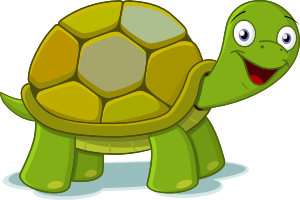Prekinder to Grade 2 Mathematics
Common Number Patters
Common Number Patters
There are a number of interesting number patterns that crop up all the time. In this article we are going to look at the ones that you see most often, and how they are formed.

Timmy the Turtle hopes to climb Mount Kosciuszko one day. He's practising hard by climbing ramps in the garden. Every hour, Timmy manages to climb \(20 \text{ cm}\). He keeps at it for hours. He writes down the heights he has climbed to in a table:
| Climbing Time (Hours) | Height Reached |
|---|---|
| 1 hour | 20 cm |
| 2 hours | 40 cm |
| 3 hours | 60 cm |
| 4 hours | 80 cm |
| 5 hours | 100 cm |
If you look at the heights that Timmy has recorded in his table, you might notice that they form a number pattern:
Arithmetic Sequence. You might see it called an
arithmetic progression in some books.
Arithmetic Sequences
Just like the sequence of heights that Timmy the Turtle has reached, an arithmetic sequence is made by starting with one number, and adding the same amount to it at each step.
For example, the sequence

If you want to work out how much is being added each time in an arithmetic sequence, subtract one term from the next term in the sequence. The difference will always be the same.
For example, the sequence

The value that we add to the last term each time is called the common difference: "difference" because you can work it out by subtracting each term from the next term in the sequence, and "common" because the answer
is the
same all the time.
For example, in the sequence
Note that the common difference doesn't have to be a positive number. In the sequence,
Geometric Sequences
Geometric sequences are number patterns in which the terms are formed by starting with a number, and multiplying it by the same number over and over again.
For example, the sequence

The number that we multiply the last term by each time is called the common ratio. In the last example, the common ratio was \(4\):

For example, the sequence

Note:The common ratio does not have to be a whole number. For example, in the sequence
The common ratio can also be a negative number. For example, you can build a sequence by starting at \(3\) and multiplying by the common ratio \(-2\) to get
Special Number Patterns
There are a lot of number patterns around that aren't arithmetic or geometric sequences. Here are some examples.
Triangular Numbers
The numbers
Square Numbers
The numbers
Pentagonal Numbers
You can also form a number pattern by counting the dots used to form pentagons of progressively bigger sizes as shown in the picture below:

Cube Numbers
The numbers
Fibonacci Numbers
Fibonacci (Leonardo of Pisa) came up with this sequence when he was thinking about populations of rabbits:

Conclusion
There are all sorts of different number patterns. Why not see if you can come up with some of your own?
Description
This mini book covers the core of Math for Foundation, Grade 1 and Grade 2 mathematics including
- Numbers
- Addition
- Subtraction
- Division
- Algebra
- Geometry
- Data
- Estimation
- Probability/Chance
- Measurement
- Time
- Money
- and much more
This material is provided free of cost for Parent looking for some tricks for their Prekinder, Kinder, Prep, Year 1 and Year 2 children
Audience
Grade 1/Year 1, Grade 2/Year 2, Prep, Foundation, Kinder and Pre-Kinder
Learning Objectives
These lessons are for kids aged 4-8 with the core objective to expose their brains to concepts of addition, subtraction, division, algebra and much more.
Author: Subject Coach
Added on: 6th Apr 2018
You must be logged in as Student to ask a Question.
None just yet!